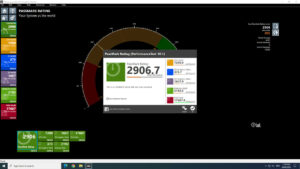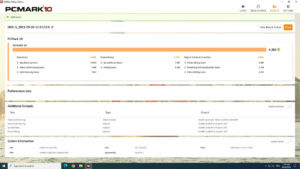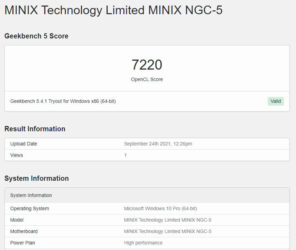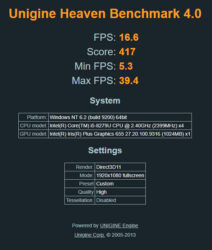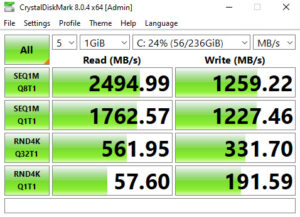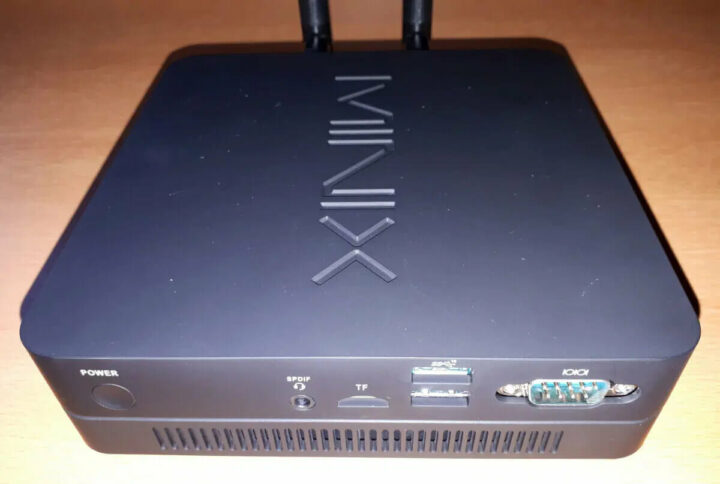
香港迷你PC和高清播放机制造商MINIX最近在其 NGC 系列中推出了一款名为 NGC-5 的新型迷你 PC。虽然该迷你PC使用的是有点过时的英特尔第八代酷睿 i5 处理器,但集成的 Iris Plus Graphics 655 却算得上是比较强大的 iGPU 解决方案之一。不久前,MINIX给我寄了一个样品用来评测。所以,本文我会讲解查看在该迷你PC上运行 Windows 和 Ubuntu,以及使用 eGPU性能的情况。
硬件概览
物理上来说,NGC-5 迷你PC是由一个 153 x 153 x 43 mm(6.02 x 6.02 x 1.57 英寸)的方形塑料外壳组成的。作为一款主动散热型的迷你 PC,它使用的是英特尔较旧的 14 nm++ Core i5-8279U Coffee Lake 处理器,这是一款四核 8 线程 2.40 GHz 处理器,通过英特尔的 Iris Plus Graphics 655 提升至了 4.10 GHz。
它的前面板只有一个 LED 电源指示灯,后面板包括双千兆以太网端口、双 USB 3.1 端口、一个 DisplayPort 1.2、一个 HDMI 2.0a 端口、一个 Type-C USB 3.1 端口和电源插孔。左侧面板有一个复位针孔、两个 wifi 天线和一个 Kensington 安全插槽。右侧面板有电源按钮、组合式耳机和 S/PDIF 插孔、一个微型 SD 卡插槽、两个 USB 3.1 端口和一个 RS232 端口。
我评测的这个型号含有一个安装了 Windows 10 Pro 的 256GB M.2 2280 NVMe SSD 驱动器和一个占据 SO-DIMM 插槽的单根 8GB DDR4 2666 MHz 内存:
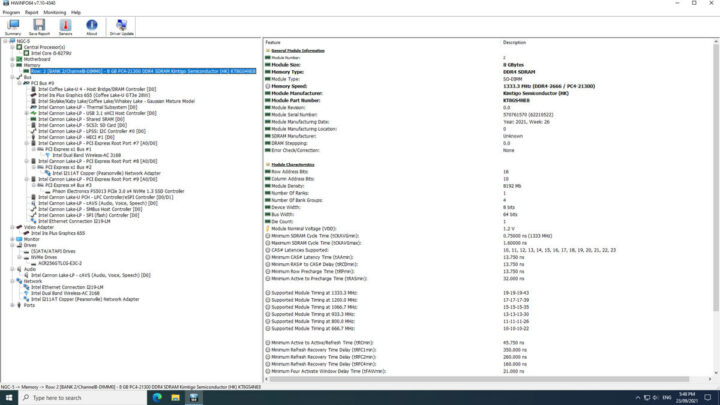
该内存可能是由不可见的 BIOS 选项配置来以 2400 MHz 运行的,正如在Windows和Ubuntu中所看到的,如下图所示:
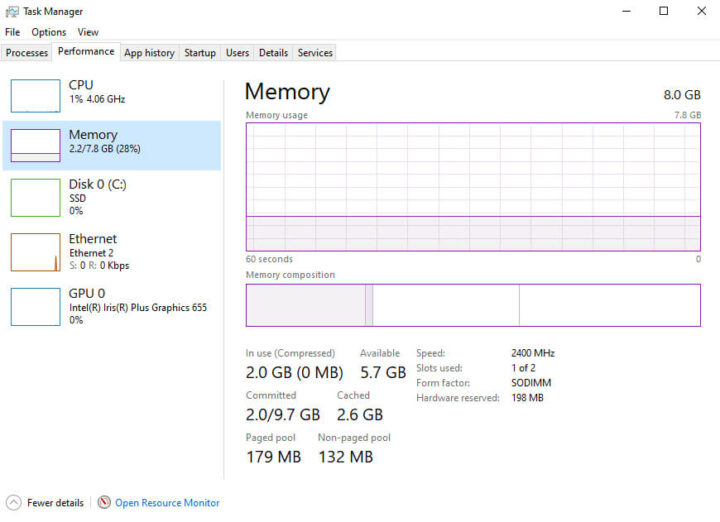
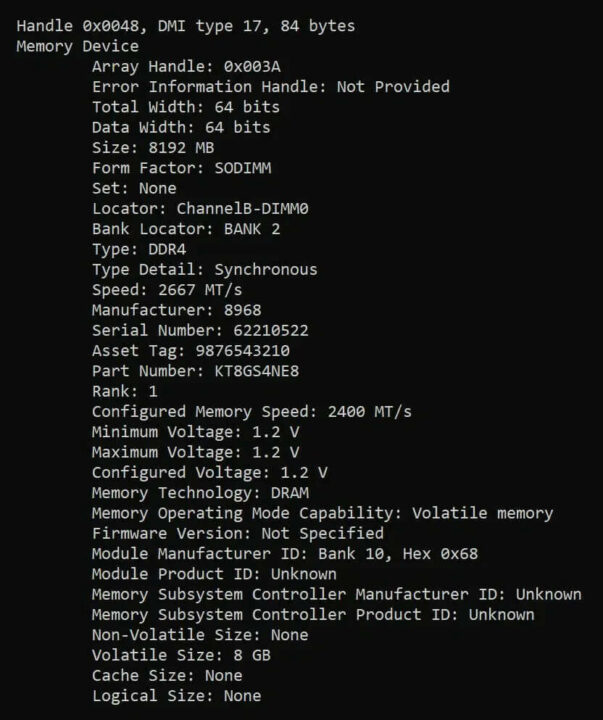
此外,还有一个 nano SIM 卡插槽、一个可更换的 M.2 2230 WiFi 5(或 802.11ac)Intel 3168NGW 卡,以及添加到额外 M.2 2242 SATA SSD 驱动器上的某种未公开功能。
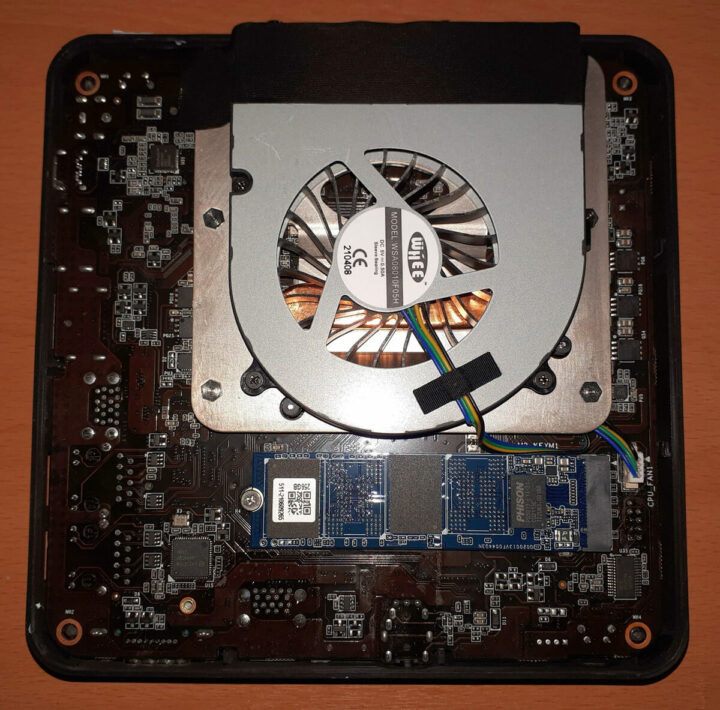
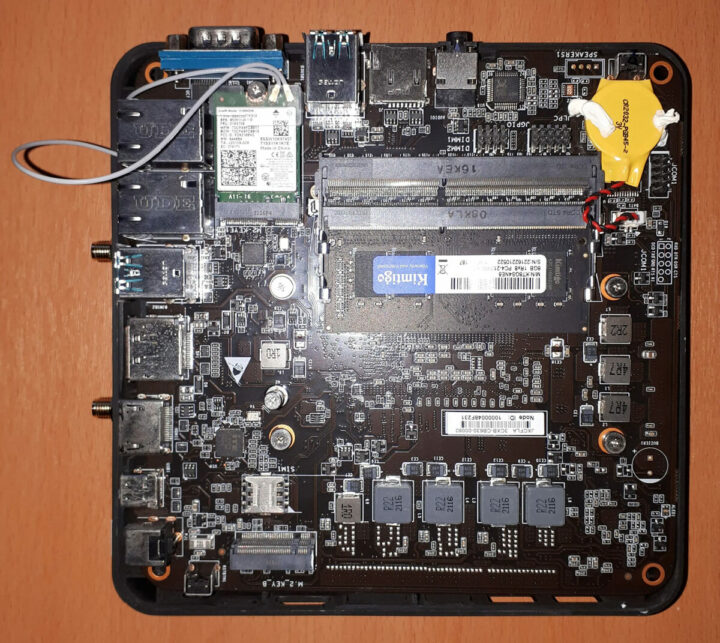
该迷你PC箱体的规格说明如下所示:

箱内物品
在整套产品套装中,你们会拿到得到一个电源适配器和适合你所在国家/地区插头的电源线、一根 HDMI 电缆、两个外部天线、一个 VESA 安装支架以及用于将设备连接到显示器后面的螺钉。你还会得到一个小塑料袋,里面有一个 S/PDIF 3.5mm 适配器、一个 M.2 固定螺丝、看起来像两个支座的东西、几块粘性橡胶,还有一个更小的袋子,里面有几个小螺丝,现在对它的用途我还是不是很清楚。还有一份欧洲多语言的用户手册。
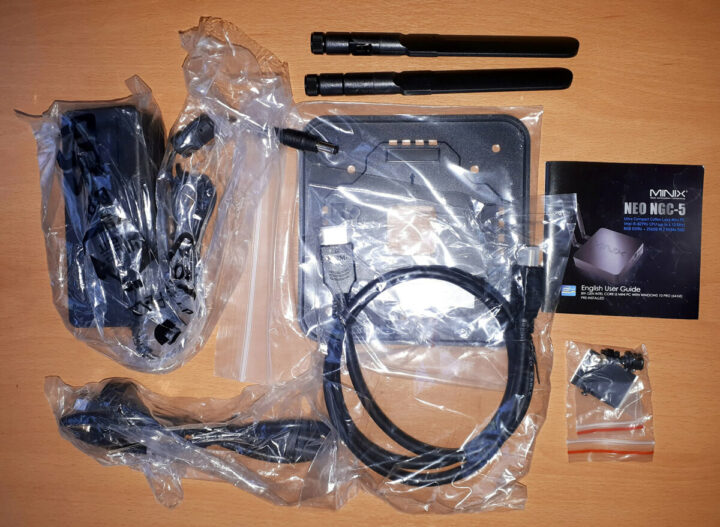
评测方法
在评测迷你 PC 时,我通常会同时查看它们在 Windows 和 Linux (Ubuntu) 下的性能,并将它们与一些最近发布的迷你 PC 进行比较。我现在正在使用 Windows 10 版本 21H1 和 Ubuntu 20.04.3 LTS 进行评测,并使用一系列常用的 Windows 基准测试、Linux 的等效测试,以及 用Thomas Kaiser 的“sbc-bench”进行测试。“sbc-bench”进行测试跟 CPU 性能测试是完全不同的,这个测试主要专注在 Ubuntu 上运行时的服务器性能。我还在 Windows 和 Ubuntu 上使用了“Phoronix 测试套件”和基准测试,用来进行比较。在 Ubuntu 上,我还使用默认配置编译的 v5.4 Linux 内核作为使用真实场景的性能测试。
在进行基准测试之前,我要先进行全部有必要的安装和更新,从而使其可以运行两个操作系统的最新版本。我还为每个操作系统截图了设备的一些基本细节。
安装问题
在初始启动时,Windows“更新”屏幕显示“some settings are managed by your organization ”(某些设置由您的组织管理)。
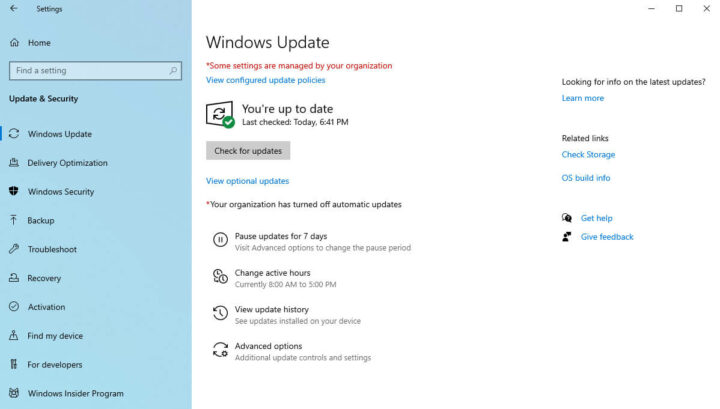
查看配置的更新策略显示自动更新且已禁用。
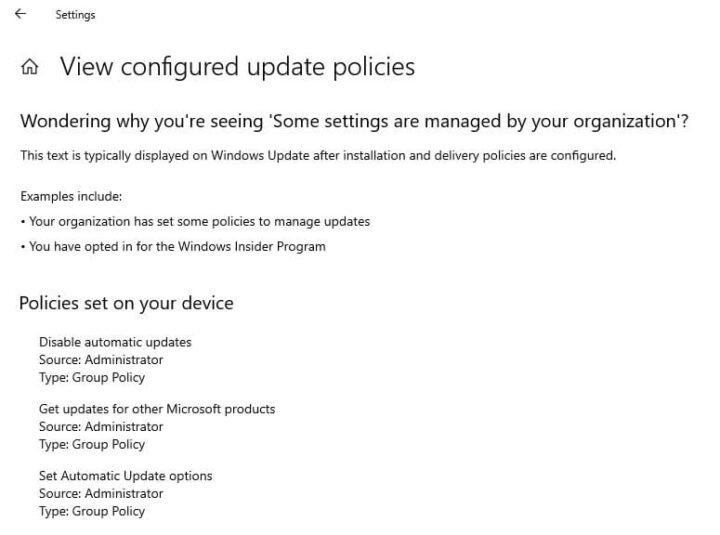
鉴于 Windows 是工厂安装,所以要检查 Windows Insider Program 确认它没有被启用。

我进一步查看之后发现,Windows更新确实已通过添加注册表项被阻止了。
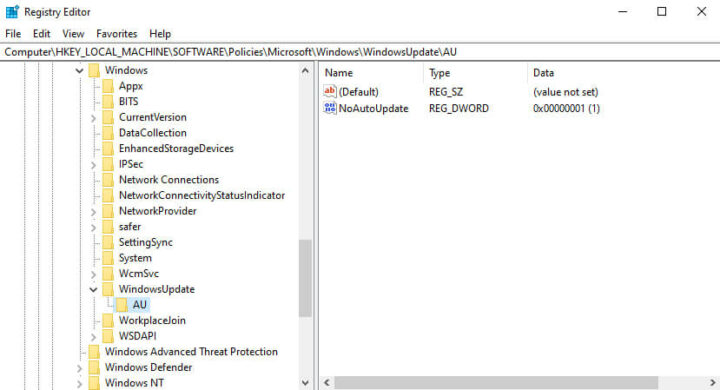
在进行WiFi测试时我发现2.4GHz网络性能很差,在我完成所有“stock”测试并打开设备以添加更多内存后,我发现网络性能很差是因为WiFi U.FL 尾纤连接器损坏了。
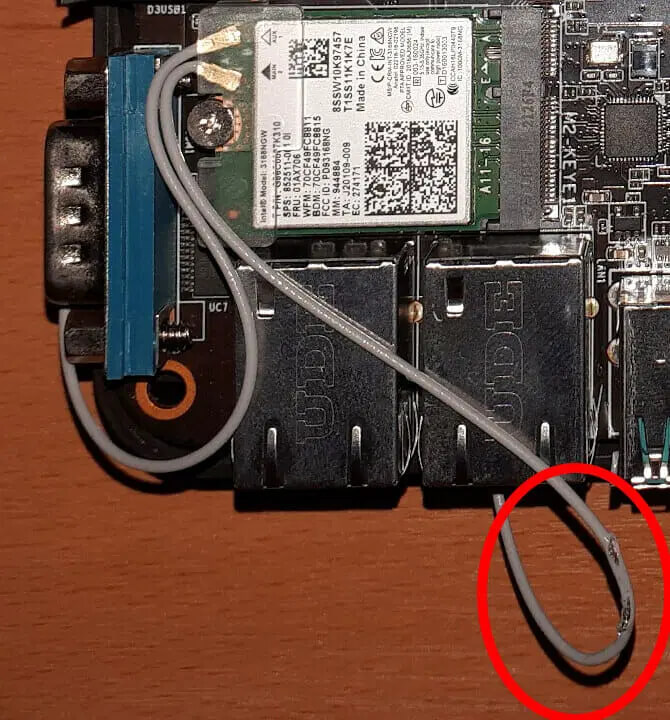
这是在制造商组装设备期间引起的,在安装调试内存时建议要特别小心,因为它需要将主板从塑料外壳中完全移除。而将主板重新安装回外壳时,WiFi 电缆很容易被卡住。
MINIX NGC-5上的Windows性能
最初,MINIX NGC-5 安装了 Windows 10 专业版 21H1 版本 19043.985 的许可副本。升级到 build 19043.1237 后,快速查看硬件信息可以看到它是符合规范的。
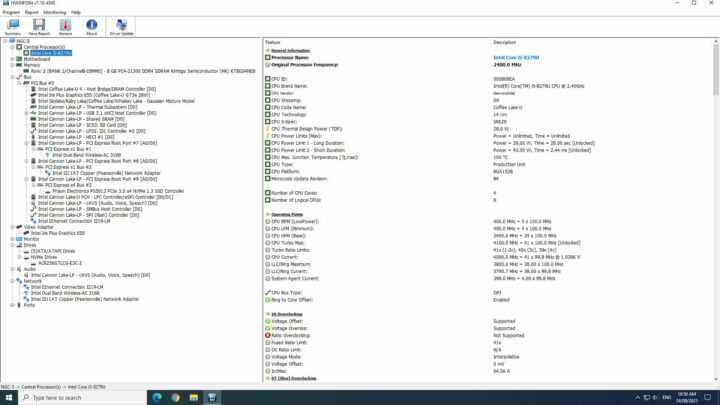
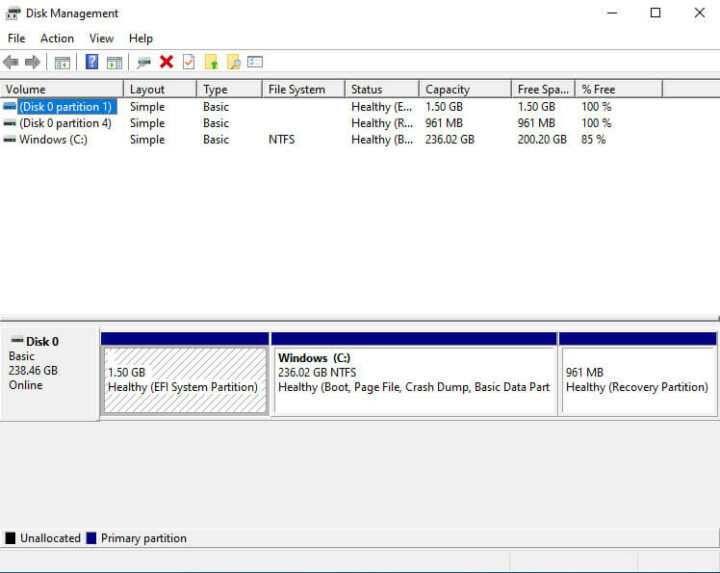
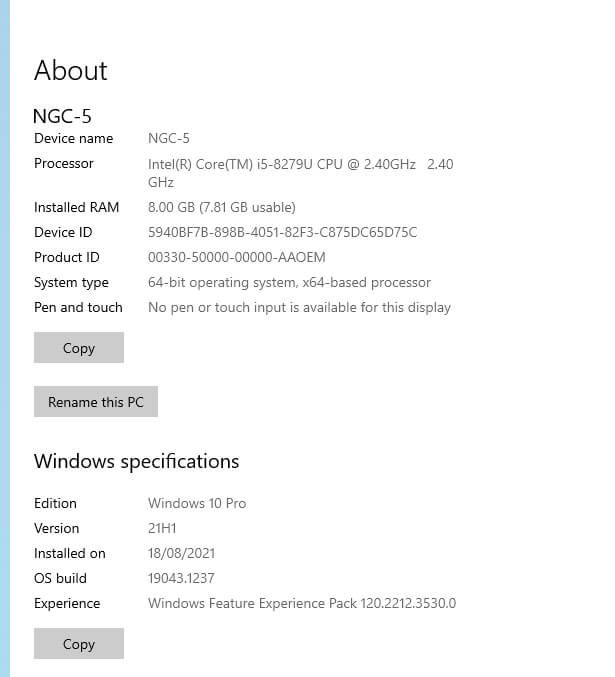
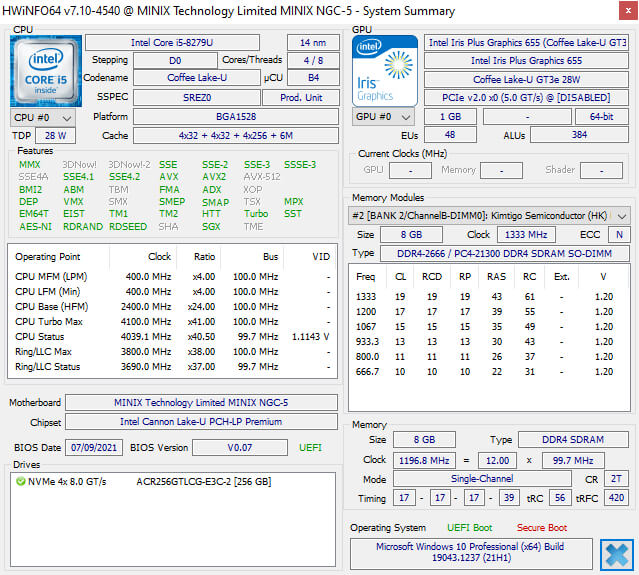
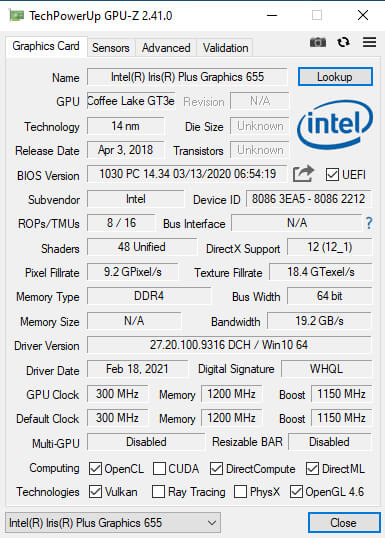
我简要检查显示音频、micro-SD、Wi-Fi、蓝牙和以太网之后,一切就都可以工作了。
然后我将电源模式设置为“高性能”并运行我的标准基准测试工具集来查看 Windows下的MINIX NGC-5性能。
对于我特定的一组 Phoronix 测试套件测试,我的测试结果如下:
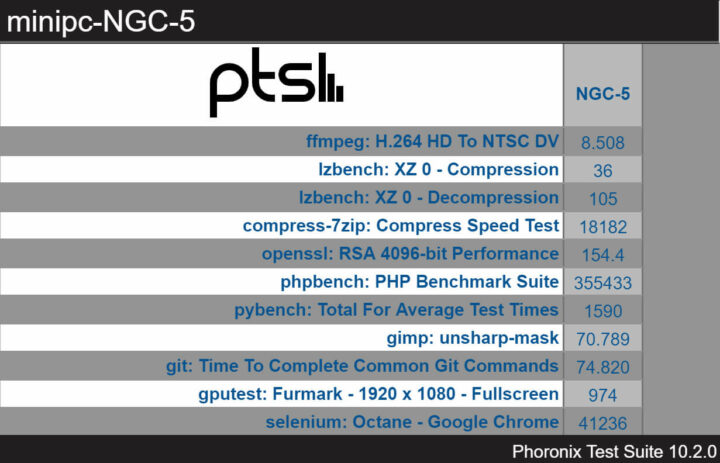
然后我将这些测试结果与其他的迷你PC进行比较,如下所示:

与使用相同或类似Core i5 CPU的其他迷你PC相比,测试结果实际上略低了一点。这是由于 CPU throttling造成的,也就是当CPU温度过高后PC会进行降频保护CPU的机制。这部分我会再下面的“Thermals”部分详细讨论。
Ubuntu性能
在将 Windows 分区缩小一半并创建一个新分区后,我使用 Ubuntu 20.04.3 ISO 作为双系统安装了 Ubuntu。安装和更新后,我简要检查了显示音频、micro- SD、Wi-Fi、蓝牙和以太网,都是正常工作的。
Ubuntu 20.04.3下关键硬件的信息如下:
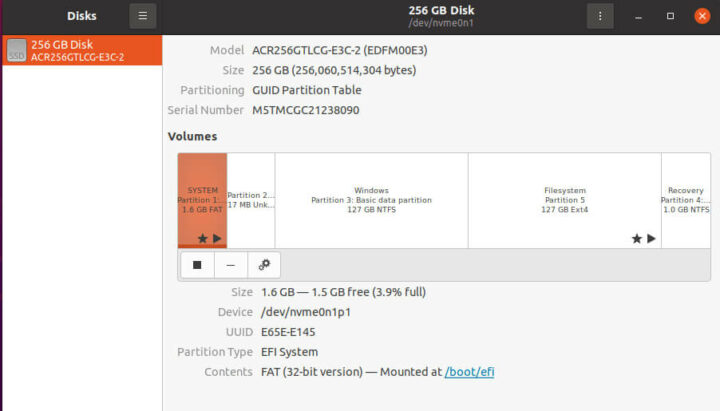
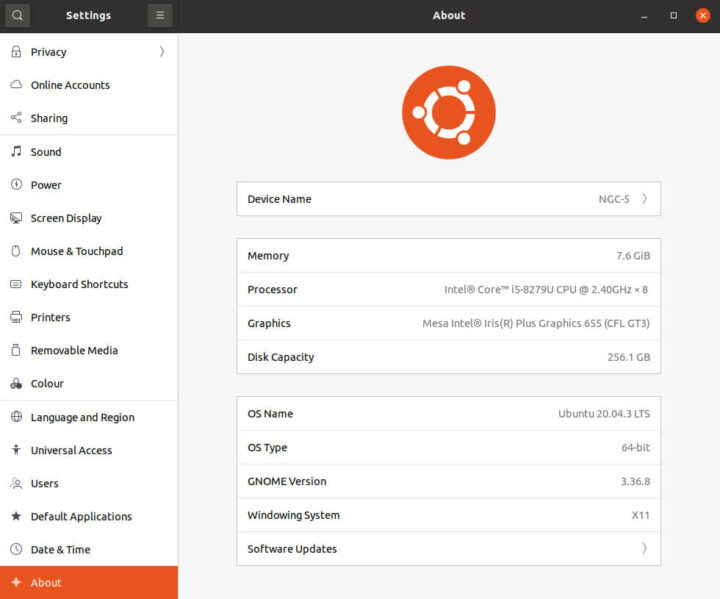
|
1 2 3 4 5 6 7 8 9 10 11 12 13 14 15 16 17 18 19 20 21 22 23 24 25 26 27 28 29 30 31 32 33 34 35 36 37 38 39 40 41 42 43 44 45 46 47 48 49 50 51 52 53 54 55 56 57 58 59 60 61 62 63 64 65 66 67 68 69 70 71 72 73 74 75 76 77 78 79 80 81 82 83 84 85 86 87 88 89 90 91 92 93 94 95 96 97 98 99 100 101 102 103 104 105 106 107 108 109 110 111 112 113 114 115 116 117 118 119 120 121 122 123 124 125 126 127 128 129 130 131 132 133 134 135 136 137 138 139 140 141 142 143 144 145 146 147 148 149 150 151 152 153 154 155 156 157 158 159 160 161 162 163 164 165 166 167 168 169 170 171 172 173 174 175 176 177 178 179 180 181 182 183 184 185 186 187 188 189 190 191 192 193 194 195 196 197 198 199 200 201 202 203 204 205 206 207 208 209 210 211 212 213 214 215 216 217 218 219 220 221 222 223 224 225 226 227 228 229 230 231 232 233 234 235 236 237 238 239 240 241 242 243 244 245 246 247 248 |
linuxium@NGC-5:~$ lsb_release -a Distributor ID: Ubuntu Description: Ubuntu 20.04.3 LTS Release: 20.04 Codename: focal linuxium@NGC-5:~$ linuxium@NGC-5:~$ uname -a Linux NGC-5 5.11.0-36-generic #40~20.04.1-Ubuntu SMP Sat Sep 18 02:14:19 UTC 2021 x86_64 x86_64 x86_64 GNU/Linux linuxium@NGC-5:~$ linuxium@NGC-5:~$ inxi -Fc0 System: Host: NGC-5 Kernel: 5.11.0-36-generic x86_64 bits: 64 Desktop: Gnome 3.36.9 Distro: Ubuntu 20.04.3 LTS (Focal Fossa) Machine: Type: Desktop Mobo: MINIX Limited model: MINIX NGC-5 serial: N/A UEFI: American Megatrends v: 0.07 date: 07/09/2021 CPU: Topology: Quad Core model: Intel Core i5-8279U bits: 64 type: MT MCP L2 cache: 6144 KiB Speed: 4101 MHz min/max: 400/4100 MHz Core speeds (MHz): 1: 4042 2: 4095 3: 4102 4: 4051 5: 4099 6: 3922 7: 4081 8: 3831 Graphics: Device-1: Intel Iris Plus Graphics 655 driver: i915 v: kernel Display: server: X.Org 1.20.11 driver: i915 resolution: 1920x1080~60Hz OpenGL: renderer: Mesa Intel Iris Plus Graphics 655 (CFL GT3) v: 4.6 Mesa 21.0.3 Audio: Device-1: Intel Cannon Point-LP High Definition Audio driver: snd_hda_intel Sound Server: ALSA v: k5.11.0-36-generic Network: Device-1: Intel Ethernet I219-LM driver: e1000e IF: eno1 state: down mac: xx:xx:xx:xx:xx:xx Device-2: Intel Dual Band Wireless-AC 3168NGW [Stone Peak] driver: iwlwifi IF: wlp1s0 state: down mac: xx:xx:xx:xx:xx:xx Device-3: Intel I211 Gigabit Network driver: igb IF: enp2s0 state: up speed: 1000 Mbps duplex: full mac: xx:xx:xx:xx:xx:xx Drives: Local Storage: total: 238.47 GiB used: 19.38 GiB (8.1%) ID-1: /dev/nvme0n1 model: ACR256GTLCG-E3C-2 size: 238.47 GiB Partition: ID-1: / size: 115.66 GiB used: 19.32 GiB (16.7%) fs: ext4 dev: /dev/nvme0n1p5 Sensors: System Temperatures: cpu: 35.0 C mobo: N/A Fan Speeds (RPM): N/A Info: Processes: 242 Uptime: 32m Memory: 7.58 GiB used: 907.3 MiB (11.7%) Shell: new-review-test inxi: 3.0.38 linuxium@NGC-5:~$ linuxium@NGC-5:~$ df -h Filesystem Size Used Avail Use% Mounted on udev 3.8G 0 3.8G 0% /dev tmpfs 776M 1.8M 774M 1% /run /dev/nvme0n1p5 116G 20G 91G 18% / tmpfs 3.8G 0 3.8G 0% /dev/shm tmpfs 5.0M 4.0K 5.0M 1% /run/lock tmpfs 3.8G 0 3.8G 0% /sys/fs/cgroup /dev/loop1 56M 56M 0 100% /snap/core18/2128 /dev/loop0 219M 219M 0 100% /snap/gnome-3-34-1804/72 /dev/loop4 51M 51M 0 100% /snap/snap-store/547 /dev/loop3 66M 66M 0 100% /snap/gtk-common-themes/1515 /dev/loop2 33M 33M 0 100% /snap/snapd/12704 /dev/nvme0n1p1 1.5G 56M 1.5G 4% /boot/efi tmpfs 776M 28K 776M 1% /run/user/1000 /dev/loop5 33M 33M 0 100% /snap/snapd/13170 /dev/loop6 128K 128K 0 100% /snap/bare/5 /dev/loop7 66M 66M 0 100% /snap/gtk-common-themes/1519 linuxium@NGC-5:~$ linuxium@NGC-5:~$ lsblk -a NAME MAJ:MIN RM SIZE RO TYPE MOUNTPOINT loop0 7:0 0 219M 1 loop /snap/gnome-3-34-1804/72 loop1 7:1 0 55.4M 1 loop /snap/core18/2128 loop2 7:2 0 32.3M 1 loop /snap/snapd/12704 loop3 7:3 0 65.1M 1 loop /snap/gtk-common-themes/1515 loop4 7:4 0 51M 1 loop /snap/snap-store/547 loop5 7:5 0 32.3M 1 loop /snap/snapd/13170 loop6 7:6 0 4K 1 loop /snap/bare/5 loop7 7:7 0 65.2M 1 loop /snap/gtk-common-themes/1519 nvme0n1 259:0 0 238.5G 0 disk ├─nvme0n1p1 259:1 0 1.5G 0 part /boot/efi ├─nvme0n1p2 259:2 0 16M 0 part ├─nvme0n1p3 259:3 0 118G 0 part ├─nvme0n1p4 259:4 0 961M 0 part └─nvme0n1p5 259:5 0 118G 0 part / linuxium@NGC-5:~$ linuxium@NGC-5:~$ sudo lshw -C cpu *-cpu description: CPU product: Intel(R) Core(TM) i5-8279U CPU @ 2.40GHz vendor: Intel Corp. physical id: 46 bus info: cpu@0 version: Intel(R) Core(TM) i5-8279U CPU @ 2.40GHz serial: To Be Filled By O.E.M. slot: U3E1 size: 4009MHz capacity: 4100MHz width: 64 bits clock: 100MHz capabilities: lm fpu fpu_exception wp vme de pse tsc msr pae mce cx8 apic sep mtrr pge mca cmov pat pse36 clflush dts acpi mmx fxsr sse sse2 ss ht tm pbe syscall nx pdpe1gb rdtscp x86-64 constant_tsc art arch_perfmon pebs bts rep_good nopl xtopology nonstop_tsc cpuid aperfmperf pni pclmulqdq dtes64 monitor ds_cpl vmx est tm2 ssse3 sdbg fma cx16 xtpr pdcm pcid sse4_1 sse4_2 x2apic movbe popcnt tsc_deadline_timer aes xsave avx f16c rdrand lahf_lm abm 3dnowprefetch cpuid_fault epb invpcid_single pti ssbd ibrs ibpb stibp tpr_shadow vnmi flexpriority ept vpid ept_ad fsgsbase tsc_adjust bmi1 avx2 smep bmi2 erms invpcid mpx rdseed adx smap clflushopt intel_pt xsaveopt xsavec xgetbv1 xsaves dtherm ida arat pln pts hwp hwp_notify hwp_act_window hwp_epp md_clear flush_l1d cpufreq configuration: cores=4 enabledcores=4 threads=8 linuxium@NGC-5:~$ linuxium@NGC-5:~$ sudo lshw -C memory *-firmware description: BIOS vendor: American Megatrends Inc. physical id: 0 version: V0.07 date: 07/09/2021 size: 64KiB capacity: 16MiB capabilities: pci upgrade shadowing cdboot bootselect socketedrom edd int13floppy1200 int13floppy720 int13floppy2880 int5printscreen int14serial int17printer acpi usb biosbootspecification uefi *-memory description: System Memory physical id: 3a slot: System board or motherboard size: 8GiB *-bank:0 description: Project-Id-Version: lshwReport-Msgid-Bugs-To: FULL NAME <EMAIL@ADDRESS>PO-Revision-Date: 2012-02-02 13:04+0000Last-Translator: Joel Addison <jaddi27@gmail.com>Language-Team: English (Australia) <en_AU@li.org>MIME-Version: 1.0Content-Type: text/plain; charset=UTF-8Content-Transfer-Encoding: 8bitX-Launchpad-Export-Date: 2021-08-02 16:47+0000X-Generator: Launchpad (build 8bd362bf86c4b35e805f897f03c203e3576a7006)Project-Id-Version: lshwReport-Msgid-Bugs-To: FULL NAME <EMAIL@ADDRESS>PO-Revision-Date: 2012-02-02 13:04+0000Last-Translator: Joel Addison <jaddi27@gmail.com>Language-Team: English (Australia) <en_AU@li.org>MIME-Version: 1.0Content-Type: text/plain; charset=UTF-8Content-Transfer-Encoding: 8bitX-Launchpad-Export-Date: 2021-08-02 16:47+0000X-Generator: Launchpad (build 8bd362bf86c4b35e805f897f03c203e3576a7006) [empty] physical id: 0 slot: ChannelA-DIMM0 *-bank:1 description: SODIMM DDR4 Synchronous 2667 MHz (0.4 ns) product: KT8GS4NE8 vendor: Numonyx (Intel) physical id: 1 serial: XXXXXXXX slot: ChannelB-DIMM0 size: 8GiB width: 64 bits clock: 2667MHz (0.4ns) *-cache:0 description: L1 cache physical id: 43 slot: L1 Cache size: 256KiB capacity: 256KiB capabilities: synchronous internal write-back unified configuration: level=1 *-cache:1 description: L2 cache physical id: 44 slot: L2 Cache size: 1MiB capacity: 1MiB capabilities: synchronous internal write-back unified configuration: level=2 *-cache:2 description: L3 cache physical id: 45 slot: L3 Cache size: 6MiB capacity: 6MiB capabilities: synchronous internal write-back unified configuration: level=3 *-memory UNCLAIMED description: RAM memory product: Cannon Point-LP Shared SRAM vendor: Intel Corporation physical id: 14.2 bus info: pci@0000:00:14.2 version: 30 width: 64 bits clock: 33MHz (30.3ns) capabilities: pm cap_list configuration: latency=0 resources: memory:a1434000-a1435fff memory:a143a000-a143afff linuxium@NGC-5:~$ linuxium@NGC-5:~$ free -mh total used free shared buff/cache available Mem: 7.6Gi 806Mi 5.0Gi 176Mi 1.7Gi 6.4Gi Swap: 2.0Gi 0B 2.0Gi linuxium@NGC-5:~$ linuxium@NGC-5:~$ sudo lshw -C network *-network description: Wireless interface product: Dual Band Wireless-AC 3168NGW [Stone Peak] vendor: Intel Corporation physical id: 0 bus info: pci@0000:01:00.0 logical name: wlp1s0 version: 10 serial: xx:xx:xx:xx:xx:xx width: 64 bits clock: 33MHz capabilities: pm msi pciexpress bus_master cap_list ethernet physical wireless configuration: broadcast=yes driver=iwlwifi driverversion=5.11.0-36-generic firmware=29.1654887522.0 3168-29.ucode latency=0 link=no multicast=yes wireless=IEEE 802.11 resources: irq:143 memory:a1300000-a1301fff *-network description: Ethernet interface product: I211 Gigabit Network Connection vendor: Intel Corporation physical id: 0 bus info: pci@0000:02:00.0 logical name: enp2s0 version: 03 serial: xx:xx:xx:xx:xx:xx size: 1Gbit/s capacity: 1Gbit/s width: 32 bits clock: 33MHz capabilities: pm msi msix pciexpress bus_master cap_list ethernet physical tp 10bt 10bt-fd 100bt 100bt-fd 1000bt-fd autonegotiation configuration: autonegotiation=on broadcast=yes driver=igb driverversion=5.11.0-36-generic duplex=full firmware=0. 6-1 ip=xxx.xxx.xxx.xxx latency=0 link=yes multicast=yes port=twisted pair speed=1Gbit/s resources: irq:19 memory:a1200000-a121ffff ioport:3000(size=32) memory:a1220000-a1223fff *-network description: Ethernet interface product: Ethernet Connection I219-LM vendor: Intel Corporation physical id: 1f.6 bus info: pci@0000:00:1f.6 logical name: eno1 version: 30 serial: xx:xx:xx:xx:xx:xx capacity: 1Gbit/s width: 32 bits clock: 33MHz capabilities: pm msi bus_master cap_list ethernet physical tp 10bt 10bt-fd 100bt 100bt-fd 1000bt-fd autonegotiation configuration: autonegotiation=on broadcast=yes driver=e1000e driverversion=5.11.0-36-generic firmware=0.13-4 latency=0 link=no multicast=yes port=twisted pair resources: irq:126 memory:a1400000-a141ffff linuxium@NGC-5:~$ linuxium@NGC-5:~$ sudo lshw -C display *-display description: VGA compatible controller product: Iris Plus Graphics 655 vendor: Intel Corporation physical id: 2 bus info: pci@0000:00:02.0 version: 01 width: 64 bits clock: 33MHz capabilities: pciexpress msi pm vga_controller bus_master cap_list rom configuration: driver=i915 latency=0 resources: irq:144 memory:a0000000-a0ffffff memory:90000000-9fffffff ioport:4000(size=64) memory:c0000-dffff linuxium@NGC-5:~$ linuxium@NGC-5:~$ lsusb Bus 002 Device 001: ID 1d6b:0003 Linux Foundation 3.0 root hub Bus 001 Device 003: ID 046d:c31c Logitech, Inc. Keyboard K120 Bus 001 Device 004: ID 8087:0aa7 Intel Corp. Bus 001 Device 002: ID 093a:2510 Pixart Imaging, Inc. Optical Mouse Bus 001 Device 001: ID 1d6b:0002 Linux Foundation 2.0 root hub linuxium@NGC-5:~$ linuxium@NGC-5:~$ lspci -nn 00:00.0 Host bridge [0600]: Intel Corporation 8th Gen Core Processor Host Bridge/DRAM Registers [8086:3ed0] (rev 08) 00:02.0 VGA compatible controller [0300]: Intel Corporation Iris Plus Graphics 655 [8086:3ea5] (rev 01) 00:08.0 System peripheral [0880]: Intel Corporation Xeon E3-1200 v5/v6 / E3-1500 v5 / 6th/7th/8th Gen Core Processor Gaussian Mixture Model [8086:1911] 00:12.0 Signal processing controller [1180]: Intel Corporation Cannon Point-LP Thermal Controller [8086:9df9] (rev 30) 00:14.0 USB controller [0c03]: Intel Corporation Cannon Point-LP USB 3.1 xHCI Controller [8086:9ded] (rev 30) 00:14.2 RAM memory [0500]: Intel Corporation Cannon Point-LP Shared SRAM [8086:9def] (rev 30) 00:14.5 SD Host controller [0805]: Intel Corporation BayHubTech Integrated SD controller [8086:9df5] (rev 30) 00:15.0 Serial bus controller [0c80]: Intel Corporation Cannon Point-LP Serial IO I2C Controller #0 [8086:9de8] (rev 30) 00:16.0 Communication controller [0780]: Intel Corporation Cannon Point-LP MEI Controller #1 [8086:9de0] (rev 30) 00:1c.0 PCI bridge [0604]: Intel Corporation Cannon Point-LP PCI Express Root Port #7 [8086:9dbe] (rev f0) 00:1c.7 PCI bridge [0604]: Intel Corporation Cannon Point PCI Express Root Port #8 [8086:9dbf] (rev f0) 00:1d.0 PCI bridge [0604]: Intel Corporation Cannon Point-LP PCI Express Root Port #9 [8086:9db0] (rev f0) 00:1f.0 ISA bridge [0601]: Intel Corporation Cannon Point-LP LPC Controller [8086:9d84] (rev 30) 00:1f.3 Audio device [0403]: Intel Corporation Cannon Point-LP High Definition Audio Controller [8086:9dc8] (rev 30) 00:1f.4 SMBus [0c05]: Intel Corporation Cannon Point-LP SMBus Controller [8086:9da3] (rev 30) 00:1f.5 Serial bus controller [0c80]: Intel Corporation Cannon Point-LP SPI Controller [8086:9da4] (rev 30) 00:1f.6 Ethernet controller [0200]: Intel Corporation Ethernet Connection I219-LM [8086:156f] (rev 30) 01:00.0 Network controller [0280]: Intel Corporation Dual Band Wireless-AC 3168NGW [Stone Peak] [8086:24fb] (rev 10) 02:00.0 Ethernet controller [0200]: Intel Corporation I211 Gigabit Network Connection [8086:1539] (rev 03) 03:00.0 Non-Volatile memory controller [0108]: Phison Electronics Corporation Device [1987:5013] (rev 01) linuxium@NGC-5:~$ |
然后我将 CPU Scaling Governor 设置为“performance”并运行了我的 Linux 基准测试,其中大部分结果都是基于文本的,图形化结果则包括如下:
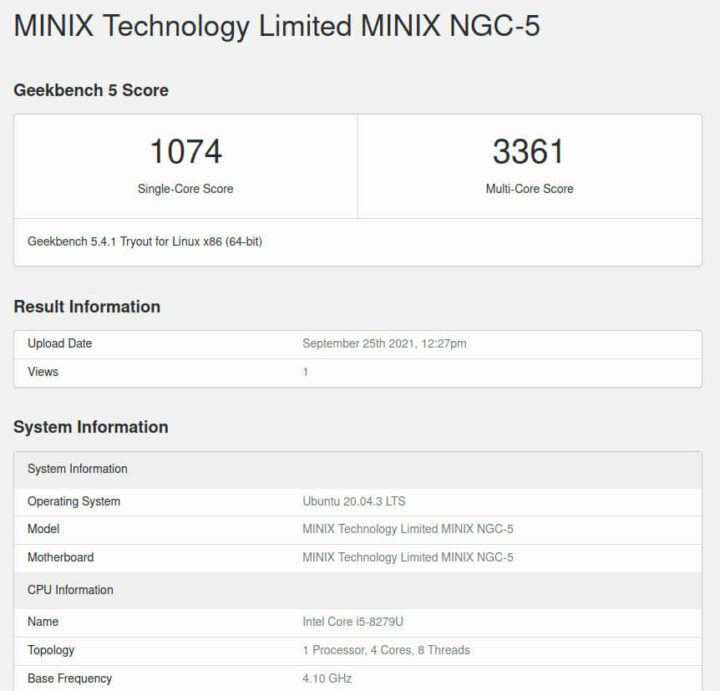

我还运行了 Passmark PerformanceTest Linux:
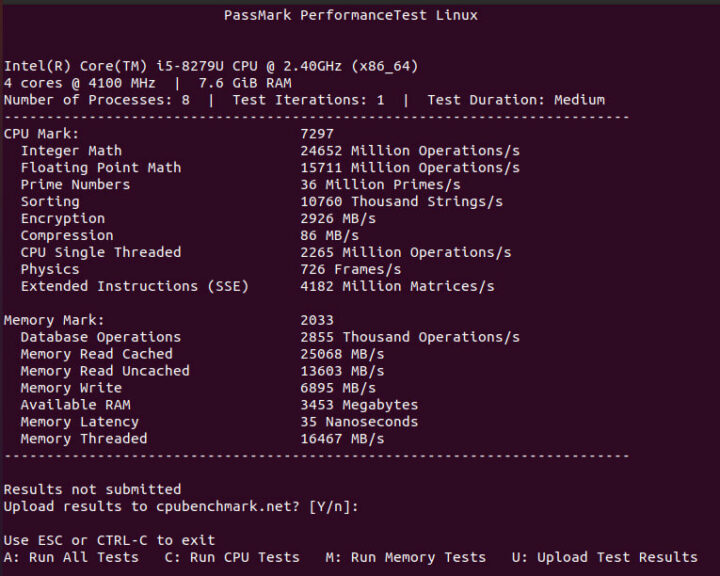
上述结果可以直接与它在 Windows 中运行时的结果进行比较:


对于同一组 Phoronix 测试套件的测试,结果如下:
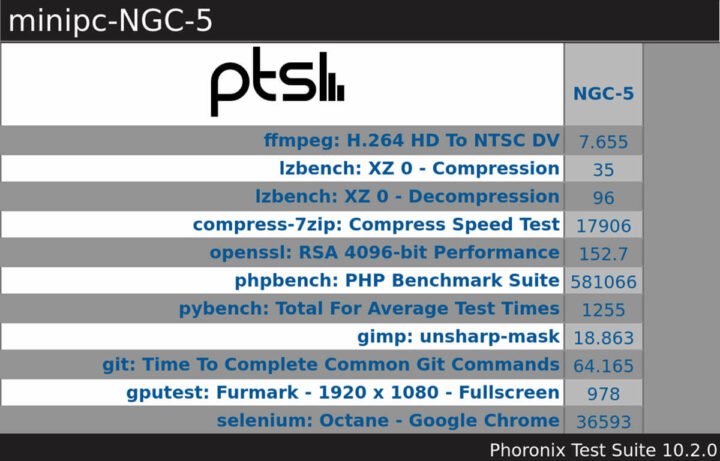
完整的结果以及与其他迷你 PC 的比较,如下图所示:

结果再次显示处理器正在节流以防止过热。
使用网络浏览器和Kodi在MINIX NGC-5上播放视频
对于现实使用场景,我通过在 Windows 上的 Edge、Chrome 、Kodi中,以及在 Ubuntu 上的 Firefox、Chrome 和 Kodi 中播放了一些视频进行测试。我发现即使我播放的是 4K 视频也没有遇到任何问题。
我还尝试在 Edge 的 YouTube 中播放 8K 视频,视频也播放正常,只是偶尔出现丢帧。

然而,在 Ubuntu 中,虽然 Chrome 运行要比 Firefox 好一些,但相同的视频却一直卡住。
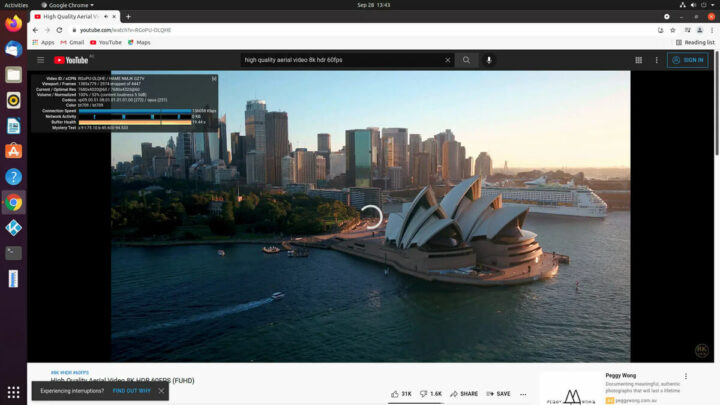
双通道内存
为了查看双通道内存的效果,我将原本的 8GB 2666 MHz 内存条换成了我自己的两个 2400 MHz 8GB 内存条。
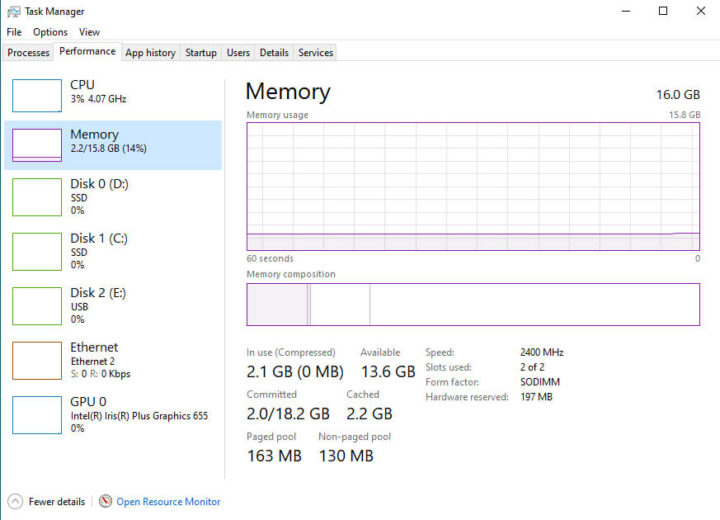
再次运行 Passmark 基于改进的memory mark,则获得了更高的评分,而且graphics marks得分也有了轻微提高。
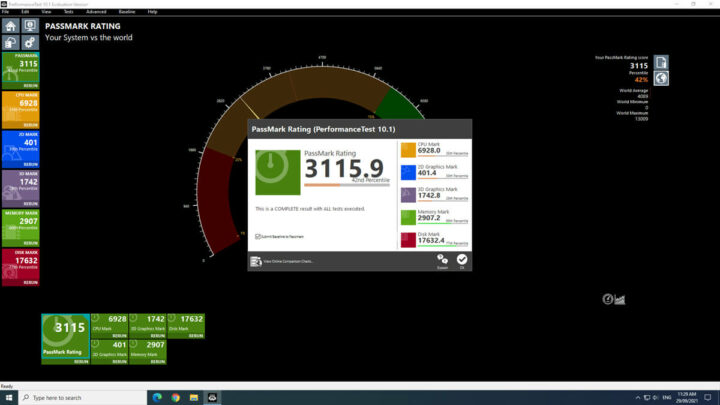
重新运行 3D Fire Strike 时也是如此,图形得分也略有增加。
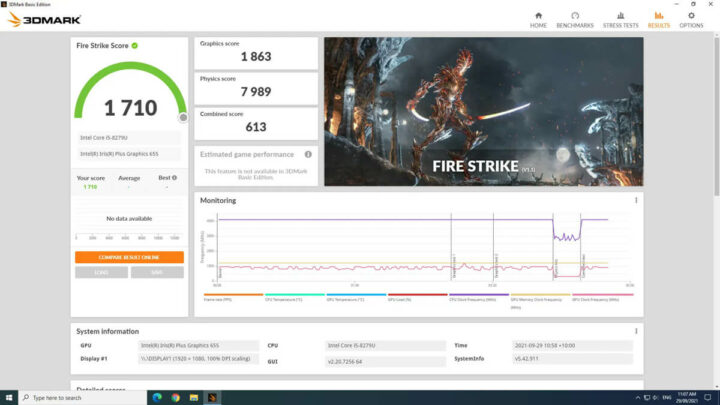
但是,重新运行 Unigine Heaven 后,结果显示图形得分略有下降。

但这可能是测试范围内的简单差异。
在Coffee Lake上玩游戏
从上面Unigine Heaven的得分可以看出是这款迷你PC是可以玩游戏的。在安装了额外内存的情况下,我在 Windows的 Steam 上测试了三款游戏(反恐精英:全球攻势、侠盗猎车手 V、古墓丽影:暗影)。在 CS:GO 和 GTA V 中的默认设置下,平均帧率分别为 43 和 37。对于在内置基准测试中使用低图形预设的 SOTTR,帧率比较令人失望,仅有9。
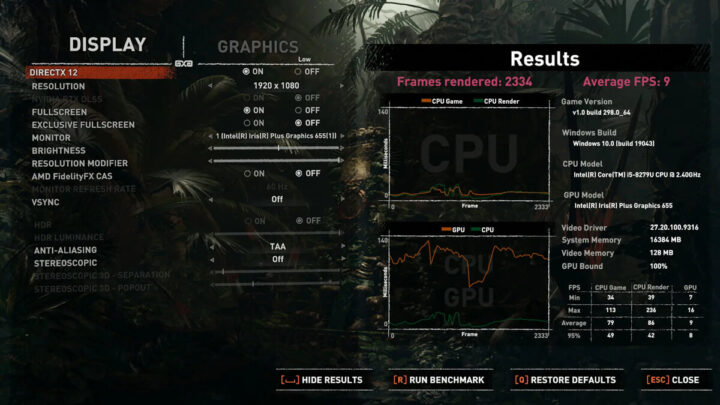
遗憾的是,MINIX NGC-5 不包含 Thunderbolt 端口,但机箱底部包含一个 M.2 2280 NVME 驱动器的接入点。

这立即让我想到通过使用“PCIe x16 到 M.2 NVMe 适配器”不显眼地将eGPU 添加到迷你 PC。根据目前的情况,即该迷你PC内部有一个空的 M.2 2242 SATA 驱动器,我当即想到可以额外安装一个更长的 80 mm驱动器。所以,我就撕掉了用来固定风扇电缆但实际上没什么用的胶带,重新使用胶带来固定更长的 SATA 驱动器,因为 M.2 支架由于 CPU 冷却器的位置而无法更换位置了。
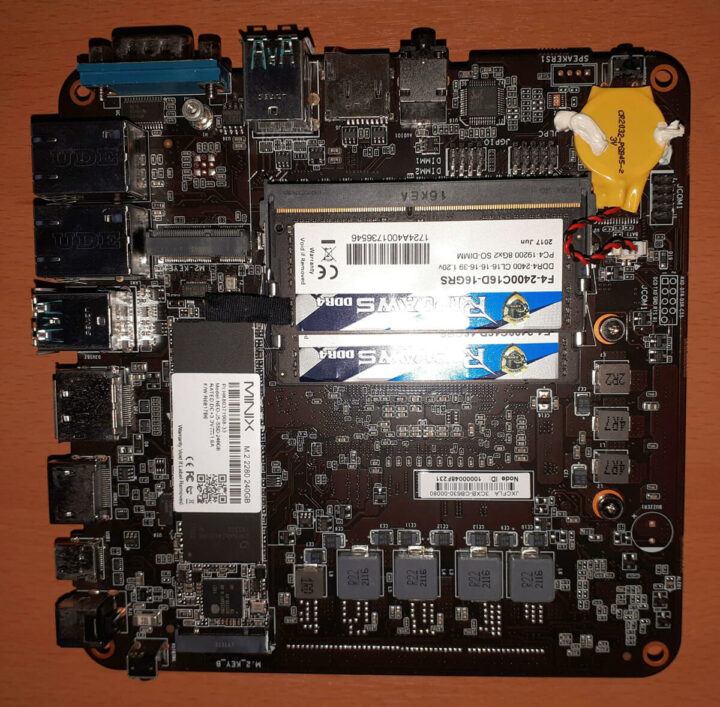
为了配置我的 eGPU,我重新使用了一个旧的MINIX NEO J5 M.2 2280 SATA 驱动器作为启动驱动器,并使用 ADT-Link 的“JHH-LINK DOCK-6”连接了 GTX 1650 Super(因为这个版本具有可互换性PCIe 电缆,使物理连接更容易)以及外部 SFX 电源和 24 针电源跳线开关。

在连接 eGPU 之前,我首先使用“dism”从 NVME 驱动器创建镜像来克隆 Windows。然后我手动移除了 NVME 驱动器并“安装”了 SATA 驱动器,接着使用“dism”运行USB和Windows ISO将镜像安装到SATA驱动器上。然后我就可以从 SATA 驱动器启动了。
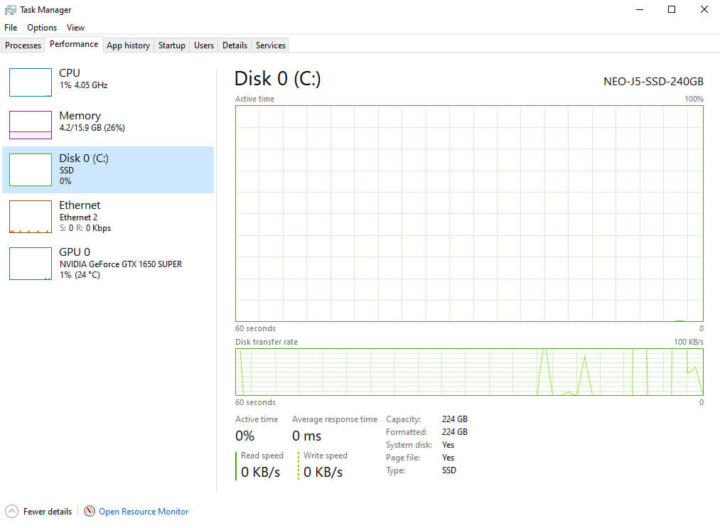
同时我也激活了 Windows 和之前安装的所有内容,包括所有必需的驱动程序。
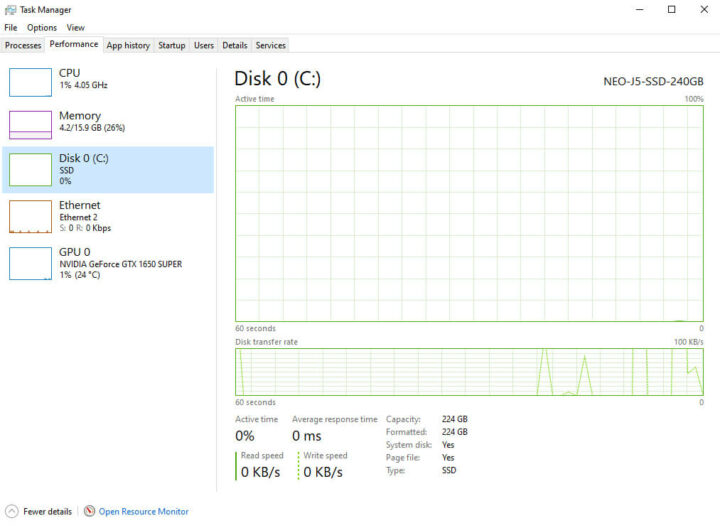
它拥有良好的驱动速度,如下图所示:

连接 eGPU 后,它显示为 PCIe x4 Gen 3:
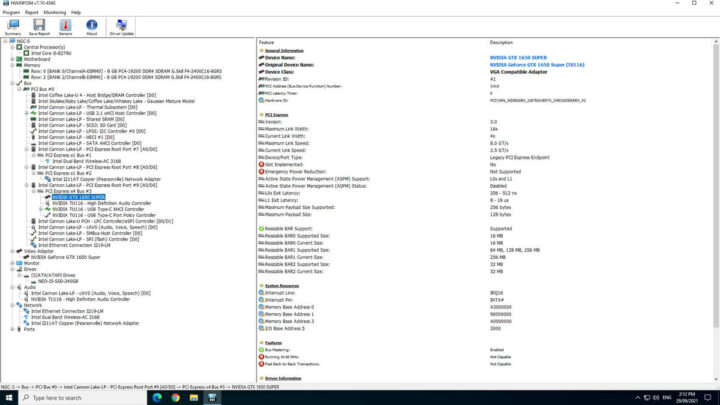
安装最新的 NVIDIA 驱动程序后,结果如下图所示:
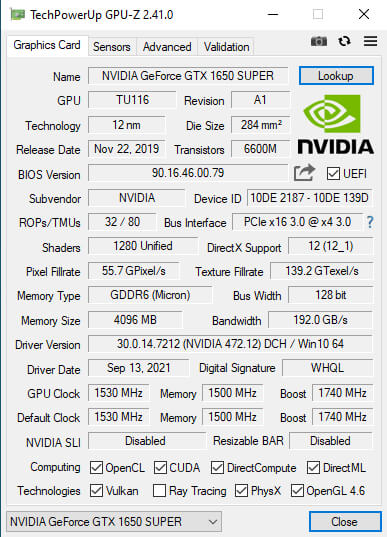
运行 CUDA-Z(显卡测试软件)也显示了预期的性能:
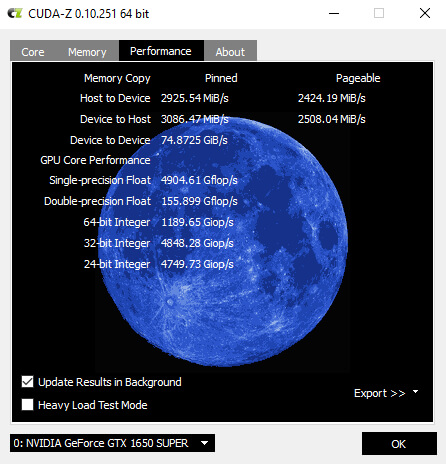
我首先运行了一些针对图形的基准测试,包括如下内容:

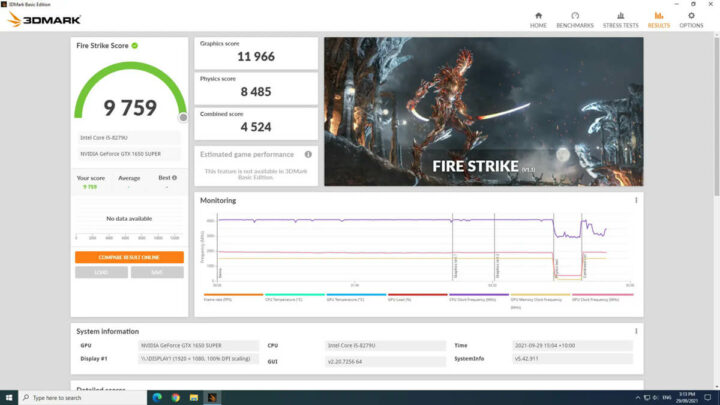
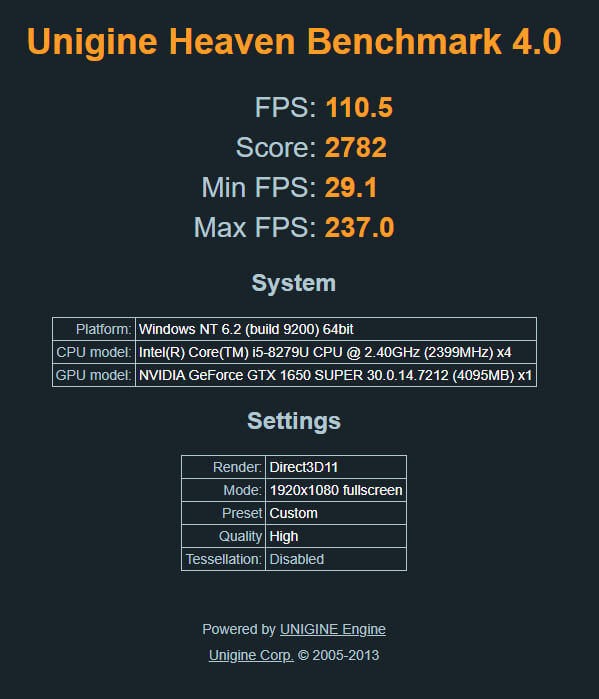
测试结果显示出很好的性能,因此我使用低图形设置的预设运行了《古墓丽影:暗影》(SOTTR) 的内置基准测试,并达到了 88 FPS,如下所示:
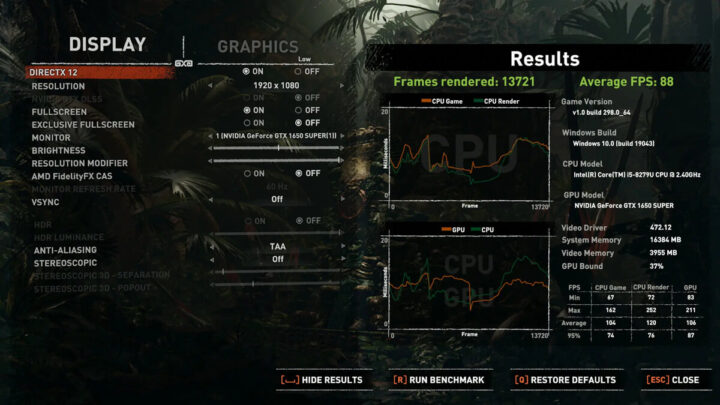
使用预设的高图形设置会降低至 64 FPS,但我觉得是可以接受的。
接下来,我尝试在默认设置的状态下运行反恐精英:全球攻势(CS:GO)并达到了大约 201 FPS。
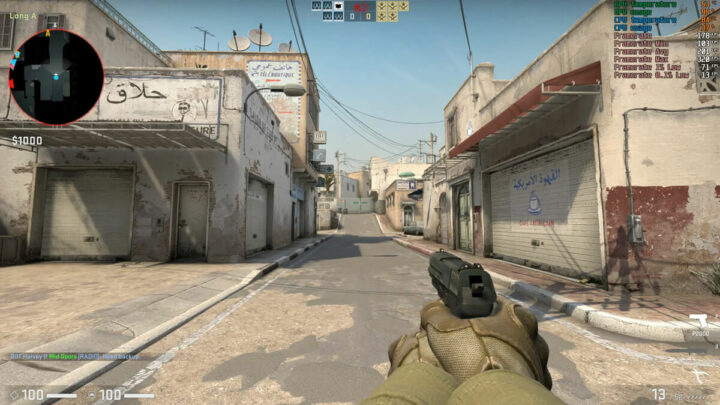
对于 Grand Theft Auto V (GTA V),在最终基准场景中,默认设置再次获得了 100 FPS。

最后,我在 SATA 驱动器上安装了 Ubuntu 作为双启动并下载并配置了最新的 NVIDIA Linux 驱动程序。
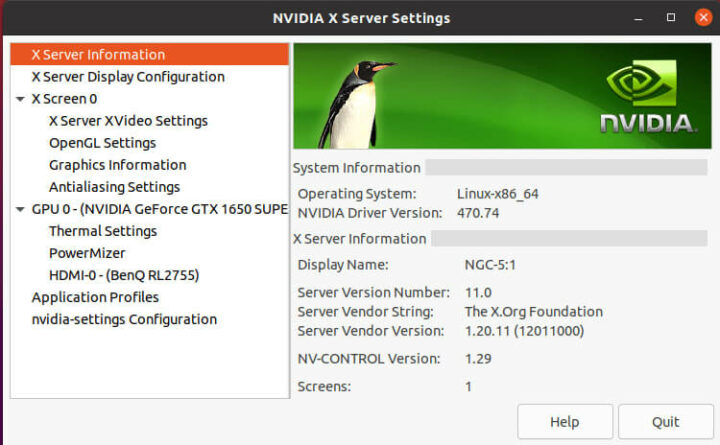
Ubuntu 现在使用的 GTX 1650 Super显卡:
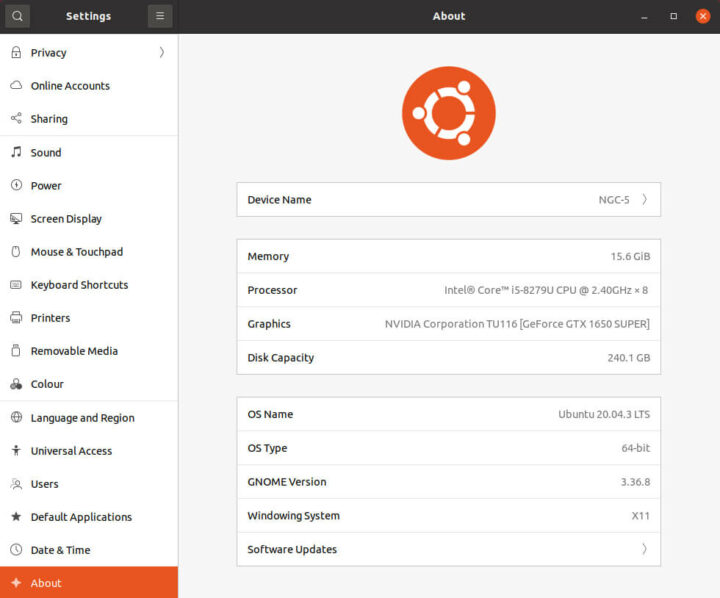
作为快速测试,我又运行了 Unigine Heaven 基准测试,结果如下所示:
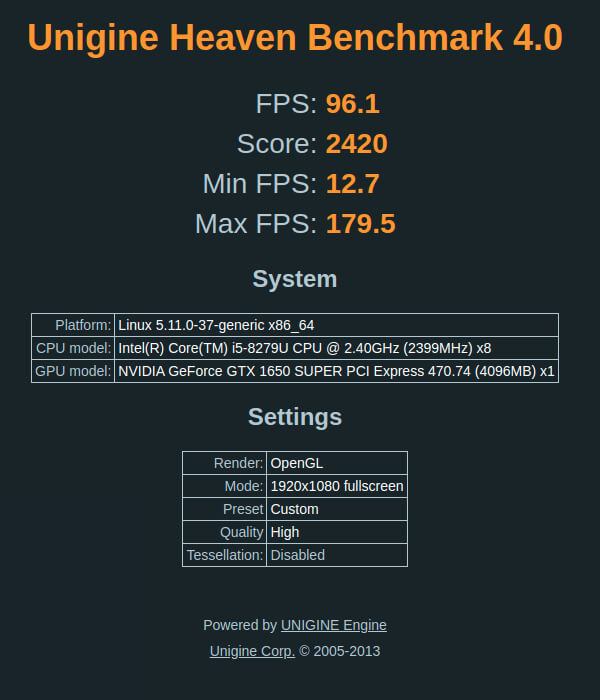
测试结果当然比在 Windows 上略低,因为它使用的是 OpenGL。
USB性能
为了验证 USB 端口的速度,我将现在未使用的 NVME 驱动器放入“USB 转 M.2 NVMe 适配器”中:
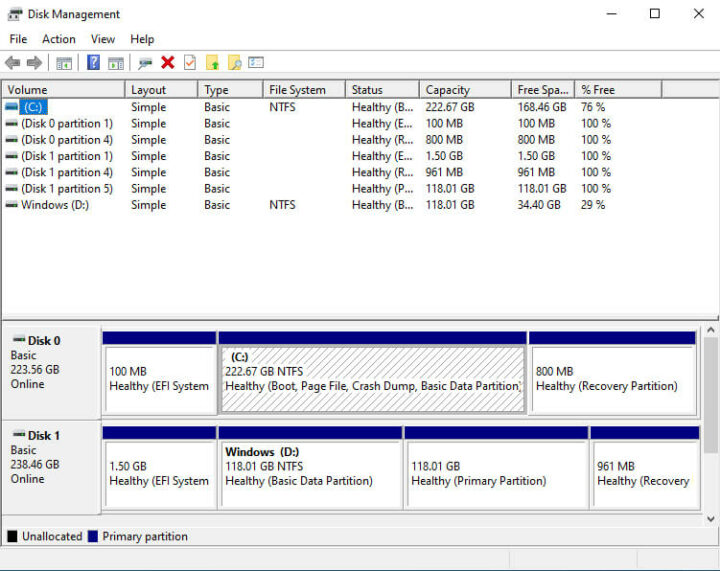
并从每个 USB 3.1(又名 USB 3.2 Gen 2×1 或 USB 3.1 Gen 2)端口实现了预期的 10Gbit/s 速度。
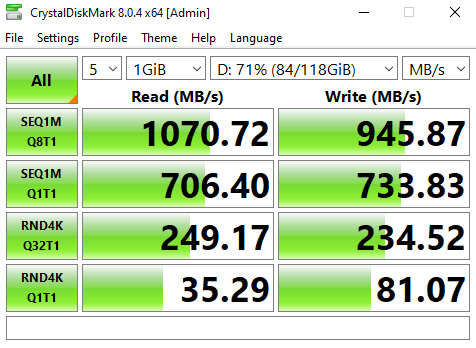
由此可以看出,安装在适配器中的 NVME 驱动器可以用作 SATA 引导驱动器的可行替代方案。
MINIX NGC-5散热
NGC-5 使用主动冷却并在 Ubuntu 上运行压力测试,可以看到 CPU 温度立即上升到了 84°C,并在测试期间保持在该温度下:

在压力测试期间,在环境室温20.3°C的情况下,我在设备顶部记录的最高温度约为35.7°C,而且我设备旁边的声表上测量到的风扇声音也并不算太大,是 42 dBA。
如果在压力测试期间监控 CPU 频率,可以看到频率立即从 4100 MHz 下降到 3000 MHz,然后逐渐下降到 2700 MHz,然后又下降到平均 2630 MHz。

CPU 频率的大幅下降是导致性能结果低于预期的原因。
网络
我在 Ubuntu 上使用“iperf”测量网络连接吞吐量:

2.4 GHz WiFi 性能不佳是由损坏的接线引起的,就像我上面“安装问题”部分中所描述的那样。
MINIX NEO NGC-5功耗
初始配置的功耗测量如下:
- 最初插入 – 0.7 W
- 断电(关机) – 0.4 W (Windows) 和 5 W(Ubuntu)
- BIOS* – 18.0 W
- GRUB 启动菜单 – 17.8 W
- 空闲 – 13.4 W(Windows) 和 11. 2 W (Ubuntu)
- CPU 压力** – 37.3 W(Windows ‘cinebench’)和 35.3 W(Ubuntu ‘stress’)
- 视频播放*** – 26.2 W(Windows Edge 4K60fps) 和 45.7 W (Ubuntu Chrome 4K60fps)
*BIOS(详细见下文)
** 60 秒后测量的指示性结果,因为 CPU throttling导致功率降低;
*** 功率数字因风扇而显著波动,因此该值是中值高功率读数和中值低功率读数的平均值。
BIOS
在 MINIX NGC-5 通电后,按 F11 键会出现一个引导菜单,其中包括对 BIOS 的访问。BIOS 非常受限制:
相关视频链接,点击此处可查看。
MINIX NGC-5上的Windows 11
值得注意的是,尽管这款迷你 PC 使用的是较旧的英特尔处理器,但它能够运行Windows 11,正如 Windows PC 检查所确认的那样:

最后的观察结论
虽然这款迷你 PC 包含一个相对强大的 Core i5 CPU,但由于高温CPU thortting,其潜力并未完全发挥。由于默认配置仅包括单通道内存,因此用户可能需要添加额外的内存条。但安装并不容易,所以必须要小心确保在拆卸/重新组装期间不会损坏 WiFi 连接器。
商业/工业使用场景通过丰富的端口选择来解决,特别是包含 RS232 和 nano-SIM 卡插槽。对于消费者而言,尽管没有 Thunderbolt 端口,但通过包含 M.2 2242 SATA 端口的可扩展性以及对 NVME 驱动器的轻松访问,也促进了“DIY”eGPU的使用。
| 强调: | 限制: |
|---|---|
| M.2 2242 SATA、RS232 和 nano SIM 卡的附加端口 | CPU 节流过度 |
| 访问 NVME 驱动器 | 难以访问内存插槽 |
最后,十分感谢 MINIX 给我提供了MINIX NGC-5用来评测。它现在的零售价大约是 560 美元,目前在速卖通上的特价是 499 美元。感兴趣的话,你们可以去了解。

文章翻译者:Jacob,嵌入式系统测试工程师、RAK高级工程师,物联网行业多年工作经验,熟悉嵌入式开发、测试各个环节,对不同产品有自己专业的分析与评估。


